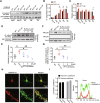GABAAR-PPT1 palmitoylation homeostasis controls synaptic transmission and circuitry oscillation
- PMID: 39695089
- PMCID: PMC11655527
- DOI: 10.1038/s41398-024-03206-1
GABAAR-PPT1 palmitoylation homeostasis controls synaptic transmission and circuitry oscillation
Abstract
The infantile neuronal ceroid lipofuscinosis, also called CLN1 disease, is a fatal neurodegenerative disease caused by mutations in the CLN1 gene encoding palmitoyl protein thioesterase 1 (PPT1). Identifying the depalmitoylation substrates of PPT1 is crucial for understanding CLN1 disease. In this study, we found that GABAAR, the critical synaptic protein essential for inhibitory neurotransmission, is a substrate of PPT1. PPT1 depalmitoylates GABAAR α1 subunit at Cystein-260, while binding to Cystein-165 and -179. Mutations of PPT1 or its GABAAR α1 subunit binding site enhanced inhibitory synaptic transmission and strengthened oscillations powers but disrupted phase coupling in CA1 region and impaired learning and memory in 1- to 2-months-old PPT1-deficient and Gabra1em1 mice. Our study highlights the critical role of PPT1 in maintaining GABAAR palmitoylation homeostasis and reveals a previously unknown molecular pathway in CLN1 diseases induced by PPT1 mutations.
© 2024. The Author(s).
Conflict of interest statement
Competing interests: The authors declare no competing interests. Ethics approval and consent to participate: The experiments did not involve tissues from humans. Animal use and procedures were performed according to the regulations and requirements of XXMU Animal Ethics Committee (No. XYLL2021053).
Figures





Similar articles
-
Loss of Depalmitoylation Disrupts Homeostatic Plasticity of AMPARs in a Mouse Model of Infantile Neuronal Ceroid Lipofuscinosis.J Neurosci. 2023 Dec 6;43(49):8317-8335. doi: 10.1523/JNEUROSCI.1113-23.2023. J Neurosci. 2023. PMID: 37884348 Free PMC article.
-
Ppt1-deficiency dysregulates lysosomal Ca++ homeostasis contributing to pathogenesis in a mouse model of CLN1 disease.J Inherit Metab Dis. 2022 May;45(3):635-656. doi: 10.1002/jimd.12485. Epub 2022 Mar 17. J Inherit Metab Dis. 2022. PMID: 35150145 Free PMC article.
-
Cln3-mutations underlying juvenile neuronal ceroid lipofuscinosis cause significantly reduced levels of Palmitoyl-protein thioesterases-1 (Ppt1)-protein and Ppt1-enzyme activity in the lysosome.J Inherit Metab Dis. 2019 Sep;42(5):944-954. doi: 10.1002/jimd.12106. Epub 2019 May 14. J Inherit Metab Dis. 2019. PMID: 31025705 Free PMC article.
-
Pathogenesis and therapies for infantile neuronal ceroid lipofuscinosis (infantile CLN1 disease).Biochim Biophys Acta. 2013 Nov;1832(11):1906-9. doi: 10.1016/j.bbadis.2013.05.026. Epub 2013 Jun 6. Biochim Biophys Acta. 2013. PMID: 23747979 Free PMC article. Review.
-
Putting proteins in their place: palmitoylation in Huntington disease and other neuropsychiatric diseases.Prog Neurobiol. 2012 May;97(2):220-38. doi: 10.1016/j.pneurobio.2011.11.002. Epub 2011 Dec 7. Prog Neurobiol. 2012. PMID: 22155432 Review.
Cited by
-
Neuronal ceroid lipofuscinosis: underlying mechanisms and emerging therapeutic targets.Nat Rev Neurol. 2025 Sep 4. doi: 10.1038/s41582-025-01132-4. Online ahead of print. Nat Rev Neurol. 2025. PMID: 40908342 Review.
References
-
- Camp LA, Verkruyse LA, Afendis SJ, Slaughter CA, Hofmann SL. Molecular cloning and expression of palmitoyl-protein thioesterase. J Biol Chem. 1994;269:23212–9. - PubMed
-
- Jin J, Zhi X, Wang X, Meng D. Protein palmitoylation and its pathophysiological relevance. J Cell Physiol. 2021;236:3220–33. - PubMed
-
- Lemonidis K, Werno MW, Greaves J, Diez-Ardanuy C, Sanchez-Perez MC, Salaun C, et al. The zDHHC family of S-acyltransferases. Biochem Soc Trans. 2015;43:217–21. - PubMed
-
- Mitchell DA, Vasudevan A, Linder ME, Deschenes RJ. Protein palmitoylation by a family of DHHC protein S-acyltransferases. J Lipid Res. 2006;47:1118–27. - PubMed
-
- Vesa J, Hellsten E, Verkruyse LA, Camp LA, Rapola J, Santavuori P, et al. Mutations in the palmitoyl protein thioesterase gene causing infantile neuronal ceroid lipofuscinosis. Nature. 1995;376:584–7. - PubMed
MeSH terms
Substances
Grants and funding
LinkOut - more resources
Full Text Sources
Miscellaneous

